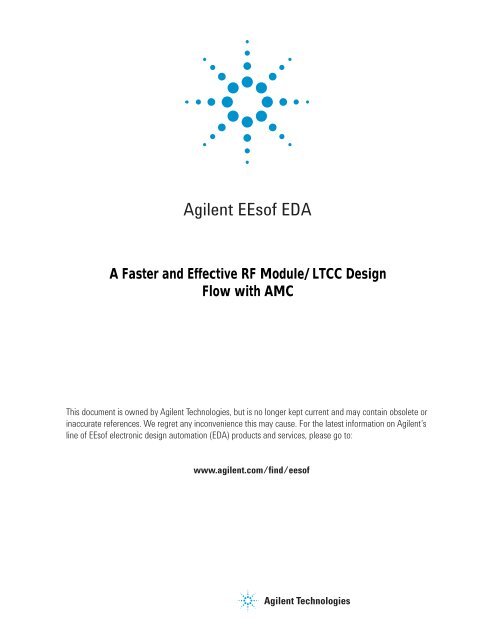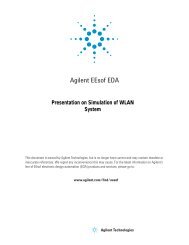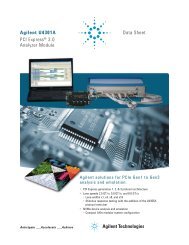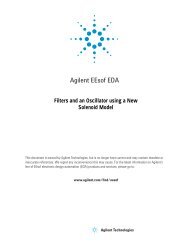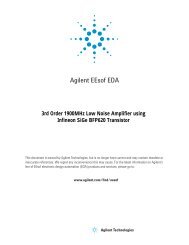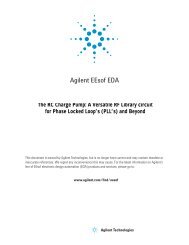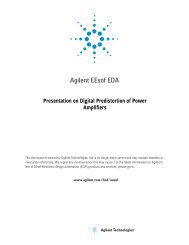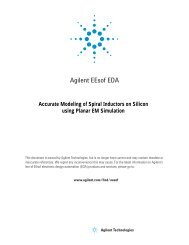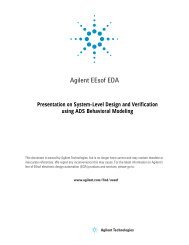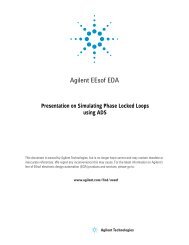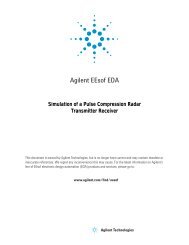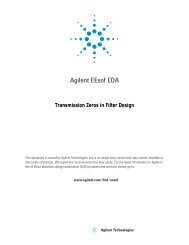A Faster and Effective RF Module/LTCC Design Flow with AMC
A Faster and Effective RF Module/LTCC Design Flow with AMC
A Faster and Effective RF Module/LTCC Design Flow with AMC
You also want an ePaper? Increase the reach of your titles
YUMPU automatically turns print PDFs into web optimized ePapers that Google loves.
Agilent EEsof EDA<br />
This document is owned by Agilent Technologies, but is no longer kept current <strong>and</strong> may contain obsolete or<br />
inaccurate references. We regret any inconvenience this may cause. For the latest information on Agilent’s<br />
line of EEsof electronic design automation (EDA) products <strong>and</strong> services, please go to:<br />
www.agilent.com/find/eesof
A <strong>Faster</strong> <strong>and</strong> <strong>Effective</strong><br />
<strong>RF</strong> <strong>Module</strong>/<strong>LTCC</strong><br />
<strong>Design</strong> <strong>Flow</strong> <strong>with</strong> <strong>AMC</strong><br />
HeeSoo LEE<br />
Agilent EEsof<br />
Page 1<br />
A <strong>Faster</strong> <strong>and</strong> <strong>Effective</strong> <strong>RF</strong> <strong>Module</strong>/<strong>LTCC</strong><br />
<strong>Design</strong> <strong>Flow</strong> <strong>with</strong> <strong>AMC</strong><br />
Version 1.0
Why Electro-Magnetic (EM) Simulation for <strong>RF</strong><br />
<strong>Module</strong>/<strong>LTCC</strong>?<br />
Majority of <strong>RF</strong> <strong>Module</strong>/<strong>LTCC</strong> components are embedded<br />
passives, integrated passives, packages, <strong>and</strong> 3D interconnects<br />
Circuit or analytical models for these components are limited<br />
since they are arbitrary geometric physical components<br />
EM simulation brings the best accuracy because:<br />
• EM simulation is based on solving Maxwell’s Equations<br />
• EM simulation can account for all parasitic interactions<br />
• EM simulation can simulate packaging effects<br />
• EM simulation take account for distributed nature of fields inside the<br />
structure<br />
Page 2<br />
A <strong>Faster</strong> <strong>and</strong> <strong>Effective</strong> <strong>RF</strong> <strong>Module</strong>/<strong>LTCC</strong><br />
<strong>Design</strong> <strong>Flow</strong> <strong>with</strong> <strong>AMC</strong><br />
Version 1.0
Today’s Three EM Simulation Technologies<br />
Method of Moments (e.g. Agilent Momentum) – <strong>LTCC</strong>, Multilayer…<br />
Finite Element Method (e.g. Agilent EMDS) – Packages, Bondwires…<br />
Finite Difference Time Domain (e.g Agilent AMDS) - Antennas<br />
Page 3<br />
A <strong>Faster</strong> <strong>and</strong> <strong>Effective</strong> <strong>RF</strong> <strong>Module</strong>/<strong>LTCC</strong><br />
<strong>Design</strong> <strong>Flow</strong> <strong>with</strong> <strong>AMC</strong><br />
Version 1.0
Momentum 3D-Planar Electromagnetic Simulator<br />
Physical Structure<br />
z<br />
Air<br />
multilayered medium<br />
3D planar<br />
metallization<br />
H(r)<br />
E(r)<br />
ε , µ σ h 1<br />
Layer [1] 1 1,<br />
1<br />
ε , µ σ h 2<br />
Layer [2] 2 2,<br />
2<br />
Port 1<br />
source<br />
ε , µ σ h 3<br />
Layer [3] 3 3,<br />
3<br />
Gnd<br />
source<br />
ω<br />
load<br />
J s (r)<br />
Port 2<br />
load<br />
[S]<br />
S-parameters<br />
Your “Virtual Network Analyzer”<br />
Page 4<br />
A <strong>Faster</strong> <strong>and</strong> <strong>Effective</strong> <strong>RF</strong> <strong>Module</strong>/<strong>LTCC</strong><br />
<strong>Design</strong> <strong>Flow</strong> <strong>with</strong> <strong>AMC</strong><br />
Version 1.0
Momentum 3D-Planar Electromagnetic Simulator<br />
Momentum simulation process:<br />
Substrate database generation<br />
Green function calculation<br />
Mesh generation<br />
B 1 (r) B 2 (r) B 3 (r)<br />
I 1 I 2<br />
I 3<br />
S 1<br />
S 2<br />
[Z].[I]=[V]<br />
[S]<br />
Adaptive frequency loop<br />
For every frequency:<br />
Matrix Load: calculate [Z] elements<br />
Square dense<br />
Computationally intensive<br />
Matrix Solve: [Z].[I] = [V]<br />
Direct <strong>and</strong> iterative solvers,<br />
support of machine optimized libraries<br />
Page 5<br />
A <strong>Faster</strong> <strong>and</strong> <strong>Effective</strong> <strong>RF</strong> <strong>Module</strong>/<strong>LTCC</strong><br />
<strong>Design</strong> <strong>Flow</strong> <strong>with</strong> <strong>AMC</strong><br />
Version 1.0
Comparing MoM (Momentum) <strong>and</strong> FEM (EMDS)<br />
Stable at DC<br />
MoM<br />
Strips, slots, <strong>and</strong> vias in infinite, planar<br />
dielectrics (3D planar)<br />
Full-wave <strong>and</strong> Quasi-static modes<br />
User controlled metal surface meshing <strong>with</strong><br />
rectangular, triangular <strong>and</strong> polygon cells<br />
Dense matrix, compression techniques<br />
Simulation time: O(N 3 ) (direct), O(N 2 )<br />
(iterative), O(NlogN) (iterative/compr.)<br />
Memory: O(N 2 ), O(NlogN)<br />
FEM<br />
Arbitrarily shaped 3D metals <strong>and</strong> dielectrics<br />
Full-wave mode<br />
Unstable at DC<br />
Adaptive tetrahedral (volumetric) mesh<br />
Sparse matrix<br />
Simulation time: square<br />
Memory: linear to square<br />
Page 6<br />
A <strong>Faster</strong> <strong>and</strong> <strong>Effective</strong> <strong>RF</strong> <strong>Module</strong>/<strong>LTCC</strong><br />
<strong>Design</strong> <strong>Flow</strong> <strong>with</strong> <strong>AMC</strong><br />
Version 1.0
Typical Three Elements of <strong>LTCC</strong> <strong>Design</strong> Process<br />
1<br />
Electrical<br />
<strong>Design</strong><br />
Physical<br />
Component<br />
<strong>Design</strong><br />
nfl<br />
Modify<br />
Layout<br />
Component<br />
<strong>Design</strong><br />
2<br />
<strong>Design</strong><br />
Requirement<br />
EM - OK?<br />
Yes<br />
No<br />
Feasibility<br />
&<br />
Topology<br />
Yes<br />
More?<br />
No<br />
Ideal Lumped<br />
Passive<br />
<strong>Design</strong><br />
3<br />
Physical<br />
Layout<br />
Physical<br />
<strong>Design</strong><br />
Full EM<br />
Verification<br />
OK?<br />
Done<br />
Yes<br />
nfl<br />
No<br />
Modify<br />
Layout<br />
Coupling<br />
Analysis<br />
Page 7<br />
A <strong>Faster</strong> <strong>and</strong> <strong>Effective</strong> <strong>RF</strong> <strong>Module</strong>/<strong>LTCC</strong><br />
<strong>Design</strong> <strong>Flow</strong> <strong>with</strong> <strong>AMC</strong><br />
Version 1.0
Critical Iterative <strong>Design</strong> Loops<br />
<strong>Design</strong><br />
Requirement<br />
Physical<br />
Component<br />
<strong>Design</strong><br />
EM - OK?<br />
Yes<br />
nfl<br />
No<br />
Modify<br />
Layout<br />
1<br />
Component<br />
Level Physical<br />
<strong>Design</strong> <strong>and</strong> EM<br />
Simulations<br />
Feasibility<br />
&<br />
Topology<br />
Yes<br />
More?<br />
No<br />
Ideal Lumped<br />
Passive<br />
<strong>Design</strong><br />
2<br />
Physical<br />
Layout<br />
Full Layout Level<br />
Physical <strong>Design</strong> <strong>and</strong><br />
EM Simulations<br />
Full EM<br />
Verification<br />
OK?<br />
Done<br />
Yes<br />
nfl<br />
No<br />
Modify<br />
Layout<br />
Coupling<br />
Analysis<br />
Page 8<br />
A <strong>Faster</strong> <strong>and</strong> <strong>Effective</strong> <strong>RF</strong> <strong>Module</strong>/<strong>LTCC</strong><br />
<strong>Design</strong> <strong>Flow</strong> <strong>with</strong> <strong>AMC</strong><br />
Version 1.0
A Method for <strong>Faster</strong> <strong>RF</strong> <strong>Module</strong>/<strong>LTCC</strong> <strong>Design</strong><br />
Circuit level simulations are generally much faster than EM<br />
simulations!<br />
Change the physical component design <strong>and</strong> EM simulations to<br />
circuit level simulations by developing<br />
• Highly accurate scalable EM-based circuit level passive models <strong>with</strong> <strong>AMC</strong><br />
Yes<br />
Physical<br />
Component<br />
<strong>Design</strong><br />
EM - OK?<br />
More?<br />
Yes<br />
No<br />
nfl<br />
No<br />
Modify<br />
Layout<br />
Component<br />
Level Physical <strong>Design</strong><br />
<strong>and</strong> EM Simulations<br />
Circuit Level<br />
Physical <strong>Design</strong><br />
<strong>with</strong> <strong>AMC</strong><br />
Yes<br />
Select <strong>AMC</strong><br />
Component<br />
(<strong>Design</strong> Kit)<br />
Tune/Opt<br />
Component<br />
Parameter<br />
No<br />
More?<br />
Page 9<br />
A <strong>Faster</strong> <strong>and</strong> <strong>Effective</strong> <strong>RF</strong> <strong>Module</strong>/<strong>LTCC</strong><br />
<strong>Design</strong> <strong>Flow</strong> <strong>with</strong> <strong>AMC</strong><br />
Version 1.0
Advanced Model Composer (<strong>AMC</strong>)<br />
EM-based passive model library generation technology<br />
• Combines the accuracy of EM <strong>with</strong> the speed of analytical models <strong>with</strong><br />
high degree of accuracy, generality, <strong>and</strong> automation<br />
• Based on Momentum technology<br />
• Unique patented modeling technology<br />
accuracy<br />
automation<br />
Models<br />
generality<br />
Page 10<br />
A <strong>Faster</strong> <strong>and</strong> <strong>Effective</strong> <strong>RF</strong> <strong>Module</strong>/<strong>LTCC</strong><br />
<strong>Design</strong> <strong>Flow</strong> <strong>with</strong> <strong>AMC</strong><br />
Version 1.0
<strong>AMC</strong>’s Multi-dimensional Adaptive Parameter<br />
Sampling (MAPS) Technology<br />
Different adaptive algorithms<br />
are combined to efficiently<br />
generate a parameterized<br />
global model:<br />
• Adaptive selection of optimal<br />
number of data samples along<br />
frequency-axis<br />
• Adaptive selection of optimal<br />
number of data samples in<br />
parameter space<br />
• Adaptive selection of optimal order<br />
of the multinomial fitting functions<br />
(independent for each parameter)<br />
Parameters<br />
data<br />
freq.<br />
Page 11<br />
A <strong>Faster</strong> <strong>and</strong> <strong>Effective</strong> <strong>RF</strong> <strong>Module</strong>/<strong>LTCC</strong><br />
<strong>Design</strong> <strong>Flow</strong> <strong>with</strong> <strong>AMC</strong><br />
Version 1.0
Advanced Model Composer Technology<br />
Key Technology 1: Adaptive Sample Selection<br />
p 2<br />
freq<br />
freq<br />
p 1<br />
Traditional approach<br />
● uniform sampling<br />
● some regions of design space<br />
oversampling : waste of resource<br />
undersampling : accuracy issue<br />
p 1<br />
p 2<br />
<strong>AMC</strong><br />
● adaptive sampling<br />
Patented<br />
technology<br />
● reflective exploration technique<br />
quasi-optimal sampling<br />
only relevant samples selected<br />
Page 12<br />
A <strong>Faster</strong> <strong>and</strong> <strong>Effective</strong> <strong>RF</strong> <strong>Module</strong>/<strong>LTCC</strong><br />
<strong>Design</strong> <strong>Flow</strong> <strong>with</strong> <strong>AMC</strong><br />
Version 1.0
Advanced Model Composer Technology<br />
Key Technology 2: Adaptive Model Selection<br />
freq<br />
p 1<br />
p 2<br />
freq<br />
Traditional approach<br />
● local interpolation<br />
● some regions of design space :<br />
over-modeling : ringing<br />
under-modeling : accuracy issue<br />
p 1<br />
p 2<br />
<strong>AMC</strong><br />
Patented<br />
technology<br />
● global adaptive modeling<br />
● Forsythe interpolation technique<br />
quasi-optimal model complexity<br />
covers complete design space<br />
Page 13<br />
A <strong>Faster</strong> <strong>and</strong> <strong>Effective</strong> <strong>RF</strong> <strong>Module</strong>/<strong>LTCC</strong><br />
<strong>Design</strong> <strong>Flow</strong> <strong>with</strong> <strong>AMC</strong><br />
Version 1.0
Two Plate Capacitor <strong>AMC</strong> Example<br />
2 Layers parallel plate series capacitor<br />
Vector<br />
Single perturbed parameter<br />
• Variable=EdgeDistFromCenter (10~50mils)<br />
• Results in the area from 20x20 to 100x100 mil 2<br />
Fast model development time<br />
EdgeDistFromCenter<br />
• 0h 2m19s <strong>with</strong> 512MB RAM <strong>and</strong> 2GHz processor<br />
PC<br />
Page 14<br />
A <strong>Faster</strong> <strong>and</strong> <strong>Effective</strong> <strong>RF</strong> <strong>Module</strong>/<strong>LTCC</strong><br />
<strong>Design</strong> <strong>Flow</strong> <strong>with</strong> <strong>AMC</strong><br />
Version 1.0
Accuracy of <strong>AMC</strong> model vs. EM Simulation<br />
50x50mil <strong>and</strong> 75x75mil parallel<br />
plates capacitors compared<br />
• Excellent agreement<br />
• Simulation speed improvement, over<br />
70x<br />
– <strong>AMC</strong>=0.89 sec<br />
– Momentum=1min 4sec<br />
Once the model is calculated,<br />
<strong>AMC</strong> provides a fast <strong>and</strong> accurate<br />
model development solution<br />
<strong>AMC</strong> Results<br />
50x50mil<br />
EM Results<br />
75x75mil<br />
Page 15<br />
A <strong>Faster</strong> <strong>and</strong> <strong>Effective</strong> <strong>RF</strong> <strong>Module</strong>/<strong>LTCC</strong><br />
<strong>Design</strong> <strong>Flow</strong> <strong>with</strong> <strong>AMC</strong><br />
Version 1.0
Multilayer Inter-Digital Capacitor <strong>AMC</strong> Example<br />
Multilayer inter-digital capacitor on 3 layers<br />
• Capacitance area: 1mm x 1mm<br />
Characteristic<br />
• 5.8pF @ 2.45GHz<br />
• S<strong>RF</strong> @ 3.7GHz<br />
1mm<br />
1mm<br />
Page 16<br />
A <strong>Faster</strong> <strong>and</strong> <strong>Effective</strong> <strong>RF</strong> <strong>Module</strong>/<strong>LTCC</strong><br />
<strong>Design</strong> <strong>Flow</strong> <strong>with</strong> <strong>AMC</strong><br />
Version 1.0
<strong>AMC</strong><br />
Parameter Sweep Simulation/Tune/Optimization<br />
<strong>AMC</strong> models allow designers to perform faster parameter<br />
sweep simulation at circuit level<br />
Finding the physical size of desired capacitance is much easier<br />
than repeated EM simulations<br />
• Example: Swept simulation of capacitor size<br />
Page 17<br />
A <strong>Faster</strong> <strong>and</strong> <strong>Effective</strong> <strong>RF</strong> <strong>Module</strong>/<strong>LTCC</strong><br />
<strong>Design</strong> <strong>Flow</strong> <strong>with</strong> <strong>AMC</strong><br />
Version 1.0
Helical Inductor <strong>AMC</strong> Example<br />
Simple to setup <strong>and</strong> model for Q-factor, Inductance, <strong>and</strong> S<strong>RF</strong><br />
Parameter (Inductor Size) swept simulation allows designers<br />
• To plot inductance <strong>and</strong> Q-factor vs size of the helical inductor<br />
m_length: ADS swept<br />
variable for Center2Edge<br />
Page 18<br />
A <strong>Faster</strong> <strong>and</strong> <strong>Effective</strong> <strong>RF</strong> <strong>Module</strong>/<strong>LTCC</strong><br />
<strong>Design</strong> <strong>Flow</strong> <strong>with</strong> <strong>AMC</strong><br />
Version 1.0
<strong>AMC</strong> Model Generation 3 Steps (Ex: Helical<br />
Inductor)<br />
Step 1-A: Create Layout Component<br />
Parameters<br />
• Only one perturbation parameter – Center2Edge<br />
– 4 edges will be perturbed by a single vector<br />
• Type = Nominal/Perturbed<br />
• Nominal (0.3mm) à Perturbed (0.5mm), dx <strong>and</strong><br />
dy = 0.2mm<br />
Center2Edge<br />
Page 19<br />
A <strong>Faster</strong> <strong>and</strong> <strong>Effective</strong> <strong>RF</strong> <strong>Module</strong>/<strong>LTCC</strong><br />
<strong>Design</strong> <strong>Flow</strong> <strong>with</strong> <strong>AMC</strong><br />
Version 1.0
<strong>AMC</strong> Model Generation 3 Steps (Ex: Helical<br />
Inductor)<br />
Step 1-B: Create Layout Component<br />
Parameters<br />
• Click “Edit/View Perturbation” menu<br />
• Set perturbation for all four directions<br />
– Select all vertices of right h<strong>and</strong> side<br />
– Apply dx=0.2 dy=0 to those vertices<br />
– Repeat for other four sides<br />
• Click OK to complete the edit<br />
dX=0.2mm<br />
Page 20<br />
A <strong>Faster</strong> <strong>and</strong> <strong>Effective</strong> <strong>RF</strong> <strong>Module</strong>/<strong>LTCC</strong><br />
<strong>Design</strong> <strong>Flow</strong> <strong>with</strong> <strong>AMC</strong><br />
Version 1.0
<strong>AMC</strong> Model Generation 3 Steps (Ex: Helical<br />
Inductor)<br />
Step 2: Create Layout Component<br />
• Menu:<br />
– “Momentum (<strong>RF</strong>)>Component>Create/Update”<br />
• It creates layout look-alike schematic symbol for<br />
schematic<br />
Library Browser<br />
Page 21<br />
A <strong>Faster</strong> <strong>and</strong> <strong>Effective</strong> <strong>RF</strong> <strong>Module</strong>/<strong>LTCC</strong><br />
<strong>Design</strong> <strong>Flow</strong> <strong>with</strong> <strong>AMC</strong><br />
Version 1.0
<strong>AMC</strong> Model Generation 3 Steps (Ex: Helical<br />
Inductor)<br />
Step 3: Generate <strong>AMC</strong> model<br />
• Menu:<br />
– “Momentum (<strong>RF</strong>)>Component>Advanced<br />
Model Composer>Create Model”<br />
• Set layout parameters for model generation<br />
– Sweep Type: Continuous Range<br />
– Min 0.25mm to Max 1.2mm<br />
• Then “Apply” <strong>and</strong> “OK”<br />
– This will launch model generation<br />
process<br />
Page 22<br />
A <strong>Faster</strong> <strong>and</strong> <strong>Effective</strong> <strong>RF</strong> <strong>Module</strong>/<strong>LTCC</strong><br />
<strong>Design</strong> <strong>Flow</strong> <strong>with</strong> <strong>AMC</strong><br />
Version 1.0
Creating <strong>AMC</strong> <strong>Design</strong> Kit (1)<br />
<strong>AMC</strong> models can be packaged into a design kit<br />
• Menu<br />
– “Momentum (<strong>RF</strong>)>Component>Advanced Model Composer><strong>Design</strong> Kit”<br />
• Steps<br />
1. Open a <strong>AMC</strong> original design that would go into a design kit<br />
2. Click the design kit menu<br />
3. Work <strong>with</strong> <strong>Design</strong> kit dialog<br />
• See next page<br />
Page 23<br />
A <strong>Faster</strong> <strong>and</strong> <strong>Effective</strong> <strong>RF</strong> <strong>Module</strong>/<strong>LTCC</strong><br />
<strong>Design</strong> <strong>Flow</strong> <strong>with</strong> <strong>AMC</strong><br />
Version 1.0
Creating <strong>AMC</strong> <strong>Design</strong> Kit (2)<br />
1<br />
Assign the name<br />
of component<br />
By default, <strong>AMC</strong> design kit is created under the<br />
directory $HOME/hpeesof/amc/design_kit<br />
2 3<br />
Enter the<br />
component<br />
description<br />
Select<br />
Model<br />
4<br />
Finish!<br />
Repeat these processes<br />
<strong>with</strong> all components that<br />
will go into the design kit.<br />
Page 24<br />
A <strong>Faster</strong> <strong>and</strong> <strong>Effective</strong> <strong>RF</strong> <strong>Module</strong>/<strong>LTCC</strong><br />
<strong>Design</strong> <strong>Flow</strong> <strong>with</strong> <strong>AMC</strong><br />
Version 1.0
A <strong>Design</strong> <strong>Flow</strong> Example Using <strong>AMC</strong><br />
In this design flow example using <strong>AMC</strong>,<br />
• 2.44GHz L/C Balun topology is used<br />
• 8 metal layers stack-up <strong>with</strong> Dupont GT943 Green Tape process is used<br />
• A design kit for helical inductors <strong>and</strong> multilayer inter-digital capacitors is<br />
pre-developed<br />
Page 25<br />
A <strong>Faster</strong> <strong>and</strong> <strong>Effective</strong> <strong>RF</strong> <strong>Module</strong>/<strong>LTCC</strong><br />
<strong>Design</strong> <strong>Flow</strong> <strong>with</strong> <strong>AMC</strong><br />
Version 1.0
Balun<br />
A Balun is a device that converts balanced impedance to<br />
unbalanced <strong>and</strong> vice versa<br />
Also Balun provides Impedance transformation<br />
• Balanced to unbalanced transformation<br />
The word Balun is a contraction of “balanced to unbalanced<br />
transformer”<br />
Page 26<br />
A <strong>Faster</strong> <strong>and</strong> <strong>Effective</strong> <strong>RF</strong> <strong>Module</strong>/<strong>LTCC</strong><br />
<strong>Design</strong> <strong>Flow</strong> <strong>with</strong> <strong>AMC</strong><br />
Version 1.0
Transmission Line Balun<br />
Transmission Line Balun<br />
Each quarter wave length<br />
transmission lines can be<br />
represented by pi-type<br />
equivalent<br />
Therefore the transmission line<br />
balun can be transformed into a<br />
LC balun circuit<br />
Reference:<br />
<strong>Design</strong> Method of a Dual B<strong>and</strong> Balun <strong>and</strong> Divider<br />
2002 IEEE MTT-S Digest<br />
Jung-Hyun Sung, Dal Ahn<br />
LC Equivalent Network<br />
Page 27<br />
A <strong>Faster</strong> <strong>and</strong> <strong>Effective</strong> <strong>RF</strong> <strong>Module</strong>/<strong>LTCC</strong><br />
<strong>Design</strong> <strong>Flow</strong> <strong>with</strong> <strong>AMC</strong><br />
Version 1.0
LC Balun Final Schematic<br />
High Pass<br />
Low Pass<br />
Resonance at f o<br />
Page 28<br />
A <strong>Faster</strong> <strong>and</strong> <strong>Effective</strong> <strong>RF</strong> <strong>Module</strong>/<strong>LTCC</strong><br />
<strong>Design</strong> <strong>Flow</strong> <strong>with</strong> <strong>AMC</strong><br />
Version 1.0
LC Balun Performance at 2.44GHz<br />
Required Inductance = 4.58nH<br />
Required Capacitance = 0.928pF<br />
Page 29<br />
A <strong>Faster</strong> <strong>and</strong> <strong>Effective</strong> <strong>RF</strong> <strong>Module</strong>/<strong>LTCC</strong><br />
<strong>Design</strong> <strong>Flow</strong> <strong>with</strong> <strong>AMC</strong><br />
Version 1.0
LC Balun <strong>with</strong> <strong>AMC</strong> components<br />
<strong>Design</strong> the LC Balun <strong>with</strong> <strong>AMC</strong> components<br />
• Inductor size: 0.295mm x 0.295mm = 4.58nH<br />
• Capacitor size: 0.24mm x 0.24mm = 0.928pF<br />
• Frequency: 1.8 ~ 3GHz<br />
de-tuned<br />
Page 30<br />
A <strong>Faster</strong> <strong>and</strong> <strong>Effective</strong> <strong>RF</strong> <strong>Module</strong>/<strong>LTCC</strong><br />
<strong>Design</strong> <strong>Flow</strong> <strong>with</strong> <strong>AMC</strong><br />
Version 1.0
Tuning <strong>AMC</strong> <strong>Design</strong><br />
Tune or optimize the <strong>AMC</strong> design for a better performance<br />
• The size of Inductor, 0.31mm, improves the performance of LC balun on<br />
loss <strong>and</strong> phase characteristic<br />
Page 31<br />
A <strong>Faster</strong> <strong>and</strong> <strong>Effective</strong> <strong>RF</strong> <strong>Module</strong>/<strong>LTCC</strong><br />
<strong>Design</strong> <strong>Flow</strong> <strong>with</strong> <strong>AMC</strong><br />
Version 1.0
Completed LC Balun Layout<br />
Component Size<br />
ADS Layout<br />
• 2.6mm x 2mm<br />
6 l<strong>and</strong> patterns<br />
• 1 input <strong>and</strong> 2 outputs, 3 ground pins<br />
Component shapes are maintained<br />
but vias <strong>and</strong> some transmission lines<br />
are added to make proper<br />
connections<br />
3D View<br />
Page 32<br />
A <strong>Faster</strong> <strong>and</strong> <strong>Effective</strong> <strong>RF</strong> <strong>Module</strong>/<strong>LTCC</strong><br />
<strong>Design</strong> <strong>Flow</strong> <strong>with</strong> <strong>AMC</strong><br />
Version 1.0
Complete EM Verification of LC Balun <strong>with</strong><br />
Momentum<br />
Page 33<br />
A <strong>Faster</strong> <strong>and</strong> <strong>Effective</strong> <strong>RF</strong> <strong>Module</strong>/<strong>LTCC</strong><br />
<strong>Design</strong> <strong>Flow</strong> <strong>with</strong> <strong>AMC</strong><br />
Version 1.0
Summary<br />
EM simulations are critical to first pass design success for <strong>RF</strong><br />
<strong>Module</strong>/<strong>LTCC</strong><br />
Agilent EEsof offers a full range of EM simulation technologies<br />
A faster <strong>and</strong> effective <strong>RF</strong> <strong>Module</strong>/<strong>LTCC</strong> design flow can be<br />
achieved by replacing repetitive component level EM<br />
simulations <strong>with</strong> the circuit level <strong>AMC</strong> models<br />
Page 34<br />
A <strong>Faster</strong> <strong>and</strong> <strong>Effective</strong> <strong>RF</strong> <strong>Module</strong>/<strong>LTCC</strong><br />
<strong>Design</strong> <strong>Flow</strong> <strong>with</strong> <strong>AMC</strong><br />
Version 1.0
For more information about<br />
Agilent EEsof EDA, visit:<br />
www.agilent.com/find/eesof<br />
Agilent Email Updates<br />
www.agilent.com/find/emailupdates<br />
Get the latest information on the<br />
products <strong>and</strong> applications you select.<br />
Agilent Direct<br />
www.agilent.com/find/agilentdirect<br />
Quickly choose <strong>and</strong> use your test<br />
equipment solutions <strong>with</strong> confidence.<br />
www.agilent.com<br />
For more information on Agilent Technologies’<br />
products, applications or services, please<br />
contact your local Agilent office. The<br />
complete list is available at:<br />
www.agilent.com/find/contactus<br />
Americas<br />
Canada (877) 894-4414<br />
Latin America 305 269 7500<br />
United States (800) 829-4444<br />
Asia Pacific<br />
Australia 1 800 629 485<br />
China 800 810 0189<br />
Hong Kong 800 938 693<br />
India 1 800 112 929<br />
Japan 0120 (421) 345<br />
Korea 080 769 0800<br />
Malaysia 1 800 888 848<br />
Singapore 1 800 375 8100<br />
Taiwan 0800 047 866<br />
Thail<strong>and</strong> 1 800 226 008<br />
Europe & Middle East<br />
Austria 0820 87 44 11<br />
Belgium 32 (0) 2 404 93 40<br />
Denmark 45 70 13 15 15<br />
Finl<strong>and</strong> 358 (0) 10 855 2100<br />
France 0825 010 700*<br />
*0.125 €/minute<br />
Germany 01805 24 6333**<br />
**0.14 €/minute<br />
Irel<strong>and</strong> 1890 924 204<br />
Israel 972-3-9288-504/544<br />
Italy 39 02 92 60 8484<br />
Netherl<strong>and</strong>s 31 (0) 20 547 2111<br />
Spain 34 (91) 631 3300<br />
Sweden 0200-88 22 55<br />
Switzerl<strong>and</strong> 0800 80 53 53<br />
United Kingdom 44 (0) 118 9276201<br />
Other European Countries:<br />
www.agilent.com/find/contactus<br />
Revised: March 27, 2008<br />
Product specifications <strong>and</strong> descriptions<br />
in this document subject to change<br />
<strong>with</strong>out notice.<br />
© Agilent Technologies, Inc. 2008


